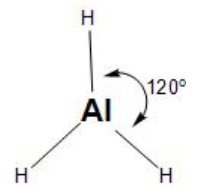Question
Question: Here, \(Al{{H}_{3}}\) is: (A)- pyramidal (B)- trigonal planar (C)- linear (D)- tetrahedral...
Here, AlH3 is:
(A)- pyramidal
(B)- trigonal planar
(C)- linear
(D)- tetrahedral
Solution
The geometry of the molecule is derived from the orientation of the hybrid orbitals, in order to minimize the repulsion between the adjacent orbitals, leading to ease in overlapping with the orbitals of the atoms to be bonded. Thus, forming a stable covalent bond.
Complete answer:
The shape of aluminium trihydride can be obtained by determining the hybridisation of the molecule, using the VSEPR theory. In the aluminium atom, with configuration [Ne]3s23p1 and having three valence electrons.
In order to bond with three hydrogen atoms, the aluminium atom in its excited state, one electron from the 3s-orbitals jumps to the 3p-orbital. Thus, having three unpaired electrons. It undergoes hybridisation of the one 3s and the two 3p-orbitals to form three sp2 hybrid orbitals with one electron each and have similar energy. The 3pz orbital is empty and is perpendicular to the sp2hybrid orbitals.
These hybrid orbitals align themselves in the corners of the triangle (at 120∘ angle) to minimise the repulsion, thus, forming the trigonal geometry.

Then, the three sp2orbitals overlap with the 1s orbital of the three hydrogen atoms, in the trigonal planar structure.
Therefore, the aluminium hydride has option (B)- trigonal planar geometry.
Note:
The octet of the aluminium atom is incomplete, having only six electrons. This is due to the empty 3pz orbital. Hence, the stable hydride is an electron-deficient molecule and a good Lewis acid.
The hydride and its derivatives are often used in the reduction of carbonyl compounds like aldehyde, ketones, esters etc, to alcohols.
